
Last Updated on
By Tony Martins
Do you carry a handgun for protection while hunting? Some rifle hunters may consider this a silly question – some bowhunters, not so much… While hunting elk, I once walked right into a pack of coyotes feeding on a carcass in the early morning darkness, carrying only my bow. Now consider that your high-powered rifle with the mega-magnification scope dialed in for 700 yard kill shots won’t offer any more protection than a bow, if a dozen growling coyotes threatening with teeth bared suddenly attack from just 20 yards away. Recalling that potentially deadly encounter still gives me the chills today. Frankly, if carrying a sidearm is legal, it’s foolish for any hunter to not do so on any hunt. In fact, my home state of Arizona recently changed regulations to allow bowhunters to carry handguns for protection. A front page story from this week’s local newspaper cites one reason – the growing concern over wolves stalking hunters. My friend and guide Billy Bishop reports that he had to fire several shots from his pistol to discourage a pack that threatened him and his horses.

Although hunters carry sidearms for a variety of reasons, probably the most common is to dispatch wounded animals. Without question, low-powered handgun rounds are more safely and accurately discharged at close range than high-powered rounds from a rifle that is usually scoped. When hunting out west, personal safety from large predators like bears, mountain lions and wolves – which often arrive in silence – is a legitimate reason. In the south and southeast, wild hogs are the primary concern, and although I’ve never hunted in Louisiana or Florida, some toothy reptiles there warrant consideration as well. Smaller animals like coyotes, badgers, bobcats, javelina, and even raccoons have all been known to threaten and injure humans. These smaller animals are a greater concern when hunting with dogs, particularly where rabies is present. And, let’s not forget snakes – particularly the venomous varieties.
So, what’s the best handgun to carry in the field for protection? In my opinion, three factors should be considered when making that choice, (1) the type of danger that could be encountered, (2) personal preference, and (3) weather conditions. The carry system is just as important, as the gun must be available for quick retrieval to be used for defensive protection, and not stowed away in a pack or saddle bag (or left in the hunting vehicle!). Recognizing this, Eberlestock has introduced the “Nosegunner” – the first binocular chest pack to incorporate a built-in pocket for a handgun. This innovative new product was featured in my “Best of SHOT – Hunting” news story just after the 2016 show in January. Following are some popular sidearm and holstering choices, with factors and circumstances for the suitability of each. Let’s start with one of my personal favorites – the Smith & Wesson .38 Special.

I rarely go into the field without my trusty 1-1/2-inch stainless S&W in my back pocket. The .38 Special was the standard service cartridge for most U.S. police departments from the 1920’s to the early 1990’s, and it has remained the most popular revolver cartridge in the world for more than 100 years! It’s accurate, comparatively inexpensive and readily available. I vividly recall the evening my father shot a screeching bobcat out of a tree at point-blank range with his S&W 3-inch service revolver, as we cut through an orchard returning late from a rabbit hunt when I was just a youngster. Growing up with, then inheriting this blued revolver (pictured above) and its leather holster on my father’s passing, the .38 Special is truly special to me.
Several years back, young friend Josh was helping our mutual friend Richie bowhunt for elk. Richie tagged one and Josh stayed with the kill while Richie hiked out to locate his truck. An hour later sitting near the carcass, Josh heard a growl and turned around to find a mountain lion claiming the downed elk. Defenseless, Josh backed away, hollering and throwing rocks at the big cat. The lion growled aggressively and advanced toward Josh when hit. Fortunately, Richie heard Josh hollering, ran to the site and shot the belligerent lion with his one remaining arrow. After relating the bone chilling story, Josh told me he was going to buy a handgun like mine the day he turned 21 and could legally do so, and never go into the woods again without it! His 2-inch Taurus Ultra-Lite (M-85UL, also pictured above) is carried in a simple belt-clip holster, or in a pocket.

Revolvers are often favored over semi-automatics for their reliability, particularly when field conditions while hunting expose the sidearm repeatedly to dirt and debris. Where foul weather is also a consideration, single-action/stainless is generally preferred over double-action/blued, especially in coastal or desert climes where salt is a factor. Popularity of cowboy-style “sixgun” revolvers derived from the legendary Colt Single Action Army remains strong – particularly in the west, where Ruger offerings like the Vaquero (pictured above) unquestionably lead the way. When more power than a .38 is desired, the .357 Mag. and .45 Long Colt models are excellent (and stylish) choices. The 4-5/8-inch Vaqueros handle great, point quickly and are easy to pack. And, although you see lots of sexy low-slung gunbelts with leg tethers, I prefer a lightweight leather or Cordura nylon hip holster that slides onto the belt of my pants, and thus rides higher for comfort while moving about in the field.
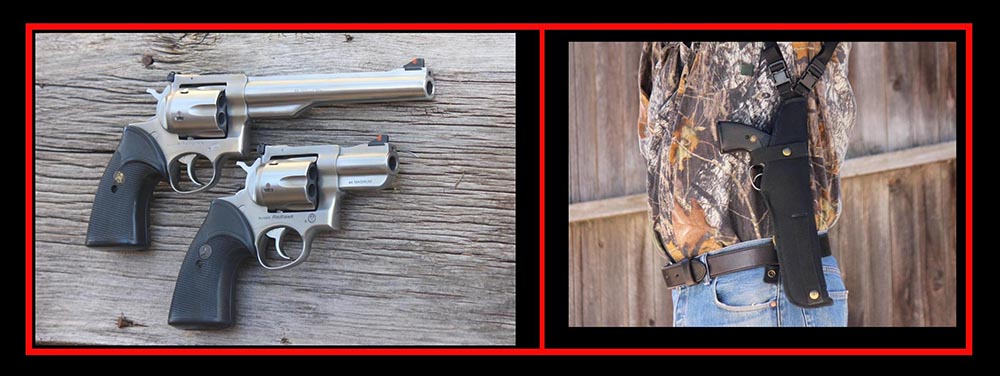
If you hunt where the great bears roam, any sidearm will do – as long as it’s chambered in .44 Remington Magnum! This is especially important in some areas in Wyoming, where grizzly bears have learned to come to the sound of a gunshot, expecting an easy meal. In my experience, the stainless steel double-action Ruger Redhawk (pictured above) is the top choice of Alaskan guides, for two main reasons; (1) the durability of this over-built handgun, and (2) dependable stopping power, particularly in foul weather conditions. When my good friend Trent Penrod sent an arrow through the chest of an approaching 8-1/2 foot Kodiak bear at a mere 15 feet, his guide stood by his side with .44 Mag. cocked and ready. The big bruin turned away, bellowing as he ran off into the bush. A loud sigh of relief followed – not from Trent, whose adrenaline was surging off the charts – but from the guide, thankful that intervention with his gun wasn’t needed! A secondary benefit is the loud report of the .44 Mag, good for both dissuading (hopefully) aggressive and dangerous animals in close quarters, and for attracting attention when needed. Preference for barrel length varies however, and those who favor long barreled models also favor vertical shoulder holsters to pack these heavy-duty sidearms around (somewhat) comfortably. Hands down, nylon is the better choice over leather for wet weather conditions.
Moving from one of the biggest sidearms carried by hunters for protection to one of the smallest, the ever-popular .22 rimfire might seem to be an illogical choice. This chambering would certainly be considered under-powered for large animals like bears, cougars, wolves and wild hogs, even in its most potent magnum version. Nevertheless, in areas where encounters with these larger animals are highly unlikely, the .22 rimfire is an excellent choice for a number of reasons. Handguns in .22 caliber are typically smaller and easier to handle than larger caliber handguns, and they are often more accurate in the hands of the inexperienced. Furthermore, ammo is comparatively cheap, so there’s a greater likelihood that their owners will have practiced enough to gain proficiency.
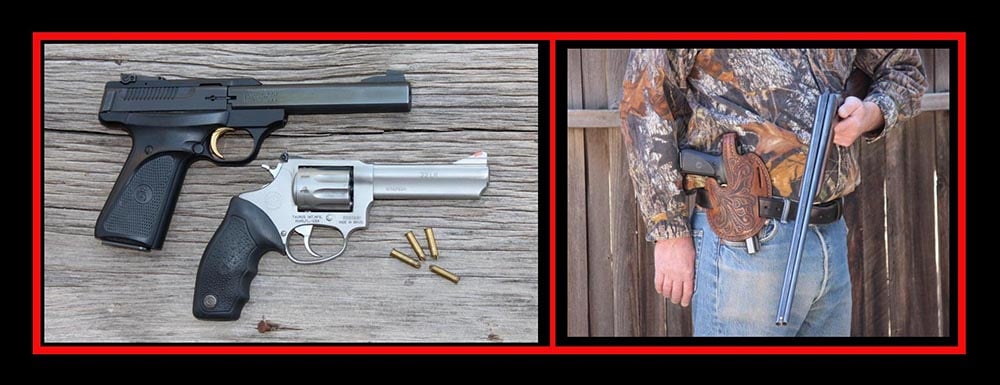
When hunting birds over dogs, scattergunners should carry a handgun – just in case a prized bird dog gets into a scrap with a wild and potentially rabid varmint. Shooting the varmint with a shotgun could wound the dog as well, and a .22 rimfire like the Browning Buck Mark or Taurus Model 94 (pictured above) is a much better solution for this problem. The similar looking Taurus Tracker Model 992SS4 Ultralite is the only double-action revolver available with interchangeable cylinders for both .22 Long Rifle and .22 Magnum – an interesting combination, if you can find one! And, in rattlesnake country, a .22 rimfire loaded with “snake shot” (#12 lead shot, also called “bird shot”) is the hands-on favorite for personal as well as canine protection. Lots of holster options are available for .22 rimfires, including fancy leather pancake models like the one holding the Buck Mark pistol shown above.
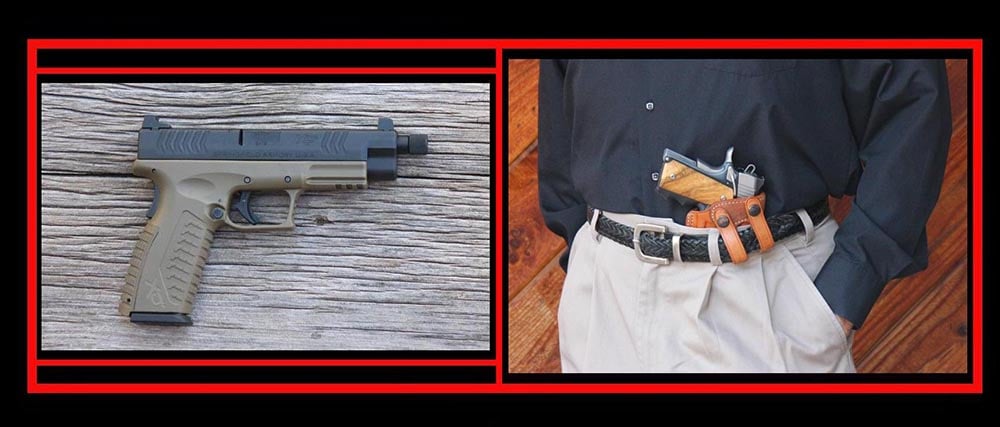
Readers may have noticed that semi-automatic pistols have received little mention so far, and high-cap magazines haven’t been mentioned at all. Most defensive encounters experienced by hunters do not require lots of ammo – typically, one or two shots will do. The important point is to have a handgun – any handgun – ready when the need arises. And, while some hunters favor a revolver for reliability and/or durability, there is nothing wrong with carrying a semi-automatic for defense while hunting. Lots of M1911’s and their modern clones are carried by hunters in the field, as many prefer the familiarity of a handgun they shoot often. Despite its comparative bulk, I’ve packed a Colt 1911 MK IV Series 70 on dozens of hunting outings for precisely this reason, and my everyday carry Kimber Ultra CDP II and Galco leather holster (pictured above, right) have been nestled against a camo hunting pattern on numerous occasions. I’ve heard that .40’s and .45’s are more popular than 9mm’s where wild hogs are a problem, but others argue that the modern +P and +P+ ammo has somewhat leveled the playing field for 9’s that can handle the higher pressure these loadings generate. Known for their reliability, Ruger P-Series semi-autos, from the original P85 to the P97, are often seen in the field. A good friend carries his P89 in 9mm while hunting, for its reliability as well as its capacity. For those who prefer the confidence that a high-cap magazine provides, a semi-auto like the Springfield Armory XD-M (pictured above, left) in 9mm is an excellent choice.
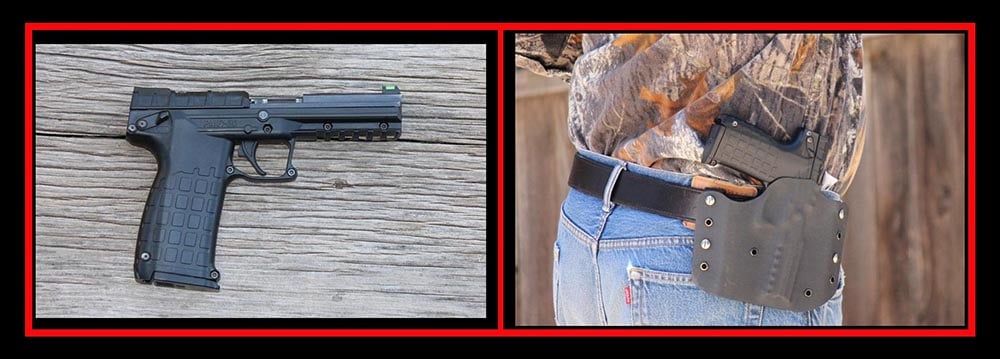
Now that the high-cap magazine card has been dealt, it’s time to play the wild card – the Kel-Tec PMR-30. I reviewed this 30-shot .22 Magnum semi-automatic handgun for Gritr Sports last year and frankly, this might be the only handgun that could have neutralized my coyote encounter noted in the opening paragraph, had it turned ugly. My good friend and gunsmith Shane Clark carries his PMR-30 regularly on our hunting outings, and there are other good reasons besides the 30-round magazine for doing so. This little blaster is very accurate, particularly for a super light gun that weighs only 13.6 oz. empty and less than 19 oz. with a full mag. I’ve carried it myself using Shane’s Kydex holster (pictured above), and you quickly forget that you’re packing a handgun. The .22 WMR cartridge is also lightweight, so it’s easy to pack lots of firepower if you like to do so. In my review I noted: “When shooting this gun you are certain to notice two things immediately – a deafening report and a spectacular fireball at the muzzle.” While these two attributes may be considered negative features for some applications, they become positives as deterrents in a defensive field encounter. I suspect that a couple of firey blasts would have sent those threatening coyotes running. Here’s another benefit of the loud report from a “warning” shot – we have used it to scare roosting ducks off the water for some subsequent pass shooting fun! A variety of handguns are available in .22 WMR, as well as its potent little cousin, the .17 HMR. Prior to development of the .17 HMR the .22 WMR was popular with predator hunters, and it remains the top choice of alligator hunters in Louisiana.
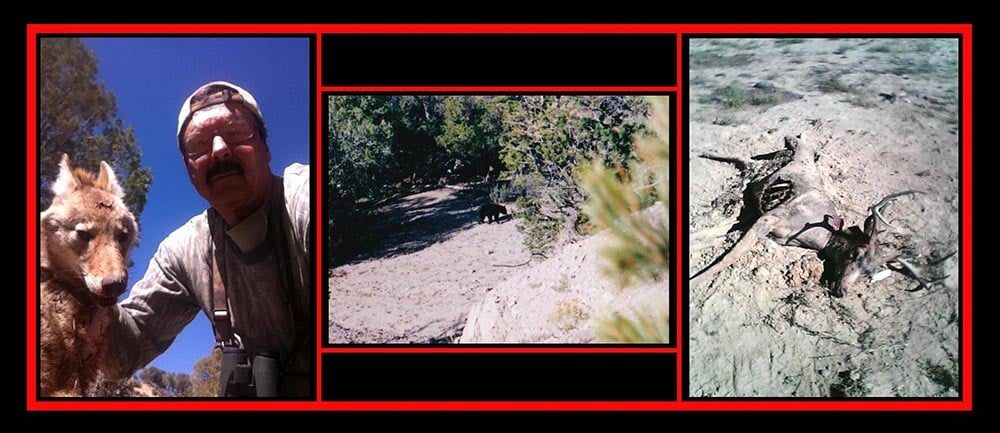
Still not convinced that a defensive sidearm is necessary while hunting? Here’s some additional food for thought: In the past 8 years I have been stalked by black bears twice, a mountain lion (once that I know about…), and even a coyote while hunting – the last was greeted by a 158 grain bullet to the forehead delivered from my trusty .38 Special at point-blank range. And, there was also the lion that ambushed the mule deer buck I was tracking on a muzzleloader hunt in New Mexico, just minutes before I arrived on the scene. Lucky for me the big cat preferred its natural prey… Interest in predator hunting has grown in recent years – and so has the incidence of mountain lions coming to predator calls, usually in silence. My good friend Freddy Diffenbaugh had a very close encounter while concealed in a brushy hideout using a mouth call. Fortunately, his hunting partner turned just in time to see a big tom crouched directly behind Freddy, only 5 feet away! And, I’ve heard about lions that came to the calls of turkey hunters as well. Consider that it’s virtually impossible to defend yourself from a cougar attacking from behind with a long rifle or shotgun… you stand a much better chance of successful defense with a handgun that is readily accessible. It’s easy to become complacent in the woods, engrossed in the enjoyment of the outing. I’ve learned that it’s wise to enjoy while maintaining alertness… and always carry a sidearm!




Leave a Reply